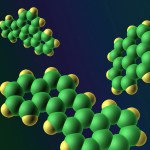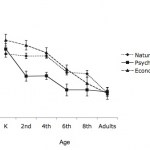
Today for Monday Pets, we're going to go old school and talk about vision.
Vision is arguably our most (intentionally) utilized sensory system, so its pretty important to figure out how it works. And it's what David Hubel and Torsten Wiesel set out to investigate starting in the late 1950s. Ultimately, their work would get them a Nobel Prize in Physiology or Medicine, in 1981.
Basically, they took a bunch of cats, anesthetized them, and showed them patterns of light on a screen. Meanwhile, some microelectrodes were placed in various precisely determined spots in the cat's visual cortex, and…
For when you have those late night pre-data-collection-week science crazies.
Yafyufa (English: The Prettiest), by Eyal Golan.
Earlier this week we talked about how to use whale snot for science.
I especially enjoyed blog bff Scicurious's take on the study:
Budgetary requirement: $5000 for series of expensive remote control helicopters.
Source: Toys R Us.
Justification: Need something that can fly close to a whale and collect snot for measurement. Also, this is the only kind that comes in red, and the gunmetal grey ones suck.
This day, however, we will travel farther, er, south. Through the mouth, down the esophagus, into the stomach, detour through the intestines, take a left at the sphincter, but, what, what's…
It's amazing how much you can learn about an animal's mind by a simply watching it.
Video 1: Gratuitous video of octopuses never hurt anyone. Maybe this will sate the Pharyngulites.
In the late 1980s, a researcher named Jennifer A. Mather wondered about octopuses' use of spatial memory. This researcher and some volunteers did some skin-diving near Bermuda and observed octopuses going out in search of food. They noticed that sometimes after catching a tasty bit of chow, the octopuses ate out, but sometimes they'd take their snack to go and eat at home. And not only that, but it turned out…
Figure 1: Research Sausage indeed. (Source)
Bloggy News:
Research Blogging now supports Polish-language posts! Polish is the sixth language supported by the site, following Chinese, Portuguese, Spanish, German, and English. We encourage new bloggers to register. If you blog about peer reviewed research in Polish (or English, Spanish, Portuguese, Chinese or German), visit our registration page to sign up. If you know a blogger in one of those languages, let them know about our site and encourage them to join.
Over 1,200 registered blogs publish dozens of posts about peer-reviewed research…
Happy Earth Day, everyone!
In honor of the day, here's a modified re-post of piece I wrote recently for LAist.
Figure 1: Photo by poloroid-girl via LAist Featured Photos on Flickr.
The great philosopher Kermit the Frog once said, "It's not that easy being green." Maybe he was on to something.
You can't walk three steps down an aisle in any store without running into eco-friendly or "green" products. You probably have many of these products. Is your refrigerator or dishwasher Energy-star compliant? Do you have a paperless Kindle? Maybe bamboo guest towels in the bathroom? A Prius?
Why do you…
Animals dream, too!
It's definitely not a seizure, and it's definitely not random motor actions. Those actions are totally coordinated. Poor dog must have been dreaming about a dog fight or something.
Figure 1: Humpback whale
The question is: what do you use to study the health of whales in the wild?
The answer is: not what you'd think.
Unlike smaller sea mammals like seals or sea lions, it is very hard to obtain blood samples from whales without first killing them.
Meet Karina Acevedo-Whitehouse, from the Zoological Society of London. She studies whale health, but has had to rely on dead, stranded or captive animals for blood samples, which are hardly representative of whales in the wild.
Figure 2: Dr. Karina Acevedo-Whitehouse
So what's the next best thing to whale blood? Well, SNOT,…
This seems to have become unofficial volcano week, here at ScienceBlogs. If you haven't been following the coverage of the Eyjafjallajökull eruption at Erik Klemetti's Eruptions blog, you should consider doing so. Also, Dr. Isis has a post on how the eruption has fouled up all nuclear imaging plans at her place of research, and Ethan explains how volcanic lightening works.
Our benevolent overlords have further commented: "Eyjafjallajökull's ill temper has been an unexpected object lesson in the complexity and interconnectedness of our environment, technology, and social networks." To that I…
As Psychology and Neuroscience Editor for ResearchBlogging.org, each week I choose 3-4 of the best posts from around the blogosphere in those categories. Here are my picks for this week:
This week, we've got an selection of posts exploring the increasingly complex and sometimes unsettling roles that social media and technology play in our social lives.
First, Erina Lee of eHarmony Labs writes about the accuracy of the online profile picture. Is an accurate photo better than a perfect photo?
Dr. Shock describes recent research investigating the relationship between Facebook use and academic…
First, this dude is hilarious:
Then, get this, once the baby gets to be about, say, baby-sized, it has to come out. At this point, it's WAY bigger than the orifice that lets it out. It's as though someone built an airplane inside of a hangar, and then when they were done, looked around and noticed that there were no airplane-sized doors. Whoopsie! This, right here, is a great argument against Intelligent Design.
Also, this guy is hilarious too. I totally forgot about him. This video was going all around back when I was in college living in campus housing.
Dog owners have a way - sometimes within DAYS of first becoming dog owners - of becoming EXPERTS on animal behavior. It blows my mind. These are people who observe their animals displaying interesting or curious behaviors and make up things like "dogs like being put in tiny cages, actually, because of when their ancestors were pack animals and lived in caves."
Figure 1: Do they look happy to you? I didn't think so.
That said, a reader sent me an email inquiring about a particular behavior that she has observed in her female poodle. This reader is not one of the above-described self-…
Didn't mean to put post two CSN(Y) jams in a row, but apparently this has been a CSN weekend.
Video of Helplessly Hoping from their 2000 tour:
And Ohio, from the Deja Vu album:
Finally, Graham Nash and David Crosby performing Guinnevere on BBC in 1970:
What is science? Fundamentally, science is a process of hypothesis-testing. Scientists observe phenomena, propose hypotheses to explain or account for some observed phenomenon, and design experiments to test those hypotheses. Then those or other scientists attempt to replicate the findings. In other words, science is performed in the following manner:
1. Define the question
2. Gather information and resources (observe)
3. Form hypothesis
4. Perform experiment and collect data
5. Analyze data
6. Interpret data and draw conclusions that serve as a starting point for new…
A recent paper from the Journal of Adolescent and Adult Literacy came across my desktop yesterday called e-Reading and e-Responding: New Tools for the Next Generation of Readers.
In it, Lotta C. Larson describes her observation of 10 fifth-grade students who were given access to an e-reader containing two recent award-winning books, both by Christopher Paul Curtis: Bud, Not Buddy, and The Watsons Go To Birmingham-1963.
She observed that at first they used the e-reader's highlighter function to mark passages that they thought they might be quizzed on. Once they realized they would not be…
Music for Brainvoyaging: Crosby, Stills, and Nash - Daylight Again.
Filmed live in 1982 at L.A.'s Universal Amphitheater
Figure 1: The Borg isn't so bad, after all.
Blog News:
What a fantastic first week in the Borg ScienceBlogs. Welcome, again, to all the new readers.
Did you miss my Psychology and Neuroscience Editor's Selections at ResearchBlogging.org? Here you go again.
You can see what I'm writing on LAist by clicking the "Other Writing" tab under the header. Here is a direct link to this piece I wrote this week, in which I explain that there have not been more earthquakes in 2010 than in previous years.
Things that I didn't get around to blogging or tweeting:
Some initiatives that the National Post-doc…
Do animals create art? So far, this seems a uniquely human ability.
But do animals have a sense of the aesthetically pleasing? What about the ability to judge and critique art? Can an animal decide if a given work of art is beautiful or ugly? What is beauty in the first place? All good questions.
Shigeru Watanabe of Keio University in Tokyo wanted to investigate the questions, with pigeons. Did he introduce them to the works of Picasso? Or Rembrandt? Romero Britto? No. He used art created by children.
Figure 1: Your kid's newest art critic.
Before we get into his experiment, lets take a…
I have a new Scibling! I only got to retain the title of newest blog here for about 24 hours, because yesterday Alex Wild's blog, Myrmecos, was assimilated into the Borg.
You might remember Alex as the first photographer featured last year at the Photo Synthesis blog. He is ScienceBlogs' new resident bug expert. Go say hi!







